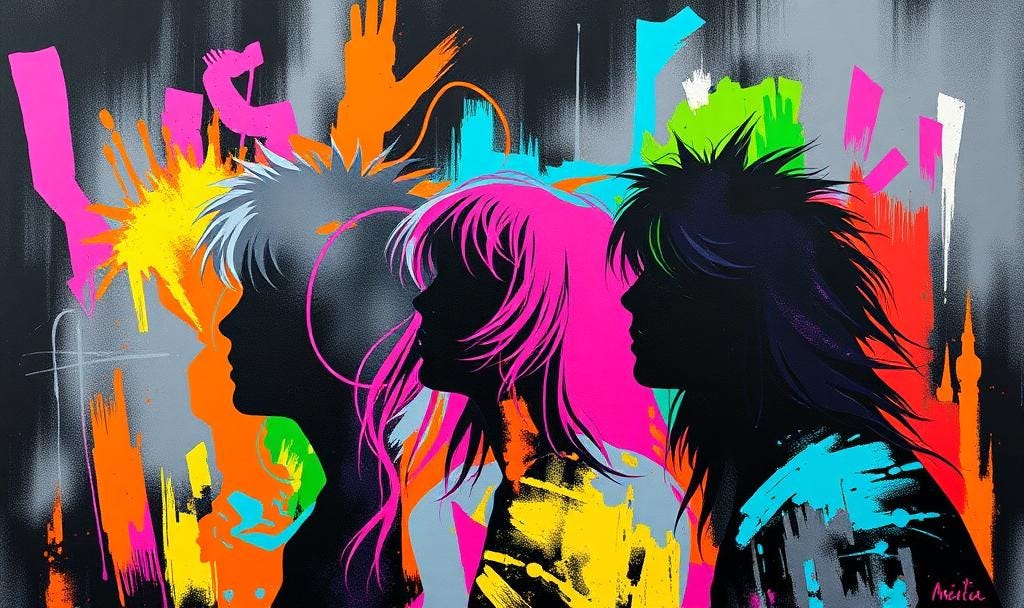This is part of my Pop Music in the ‘80s series.
The Spirit of Punk in the 1980s
By the early 1980s, punk rock had already made its mark. The late ‘70s had been defined by the raw aggression of bands like the Ramones, The Clash, and the Sex Pistols, who rejected the excess of mainstream rock in favor of something more direct and confrontational. But while punk’s initial wave had begun to fade from the mainstream, its influence was far from over.
Instead of disappearing, punk fragmented, evolved, and thrived in the underground. The ‘80s saw a shift from the more fashion-conscious punk of the late ‘70s toward a harder, faster, and more aggressive style. In the US, the punk ethos found new life in hardcore, while in the UK, it fueled the rise of anarcho-punk and post-punk movements.
Hardcore Punk and the DIY Ethic
American hardcore punk in the 1980s emerged as the rawest, most visceral form of the genre to date. Headlined by bands like Black Flag, Minor Threat, and Bad Brains, hardcore stripped punk down to its most essential elements: fast tempos, shouted vocals, and an unrelenting energy. Unlike their predecessors, who still operated within the larger music industry, hardcore bands rejected corporate influence entirely. Instead, they embraced self-released records, independent venues, and word-of-mouth promotion.
Hardcore scenes flourished in cities across the country, each developing its own identity. Washington, D.C. became a hub of politically charged punk, with the band Minor Threat defining the straight-edge movement. Los Angeles saw the rise of bands like Circle Jerks and Fear, known for their aggressive and sometimes chaotic shows. Meanwhile, New York’s hardcore scene, led by groups like Agnostic Front, blended punk with early metal influences, paving the way for crossover thrash.
Hardcore’s DIY ethic extended beyond records and concerts into self-published fanzines, independent labels like Dischord and SST Records, and alternative networks of like-minded artists and activists.
Anarcho-Punk and Political Resistance
In the UK, punk’s second wave took on a more explicitly politically active tone. Anarcho-punk, led by bands like Crass and Conflict, pushed punk’s anti-establishment ideals even further. These bands used their music as a platform for anarchist philosophy, animal rights, anti-war activism, and social critique. Crass, in particular, rejected traditional rock stardom, choosing instead to operate as a collective, self-releasing albums and using their platform to advocate for radical political change.
Musically, anarcho-punk was more about message-driven intensity than commercial appeal. Lyrics were often blunt and covered topics ranging from government corruption to gender inequality. The movement’s influence extended beyond the music, fostering a network of independent record labels, squatter communities, and alternative media that embodied punk rock’s rebellious spirit.
Crossover and the Blurring of Genres
While hardcore and anarcho-punk remained deeply underground, some punk bands began blending their sound with other genres, leading to new stylistic developments. The Misfits merged punk with horror aesthetics, laying the groundwork for horror punk and influencing later goth and metal bands. Hüsker Dü and the Replacements infused punk energy with melody, paving the way for alternative rock’s rise.
On the heavier end, bands like Suicidal Tendencies and D.R.I. brought the intensity of metal into the punk aesthetic, leading to the rise of crossover thrash. This hybrid genre would go on to influence the emerging thrash metal scene, connecting punk’s ethos with metal’s technical aggression and eventually leading to mosh pits.
The Lasting Impact of ‘80s Punk
By the end of the decade, punk rock had transformed from what many believed to be a fleeting trend to a full-on sustained musical movement that had permanently reshaped the industry. While hardcore and anarcho-punk never became commercial juggernauts, their influence is evident and could be seen in countless bands in the coming decades. The “punk rock” DIY ethic pioneered by punk would become the blueprint for independent music scenes worldwide.
As the ‘90s approached, punk’s influence became undeniable. The hardcore scene laid the foundation for later alternative and grunge movements, while the underground ethos inspired a new generation of musicians. The ‘80s were punk’s proving grounds, and the genre came out the other side as an ongoing cultural force, constantly evolving and redefining itself.

